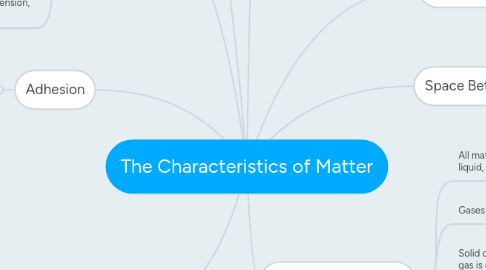
1. Changes in Matter
1.1. Changes are either physical, chemical, or nuclear
1.1.1. Physical and chemical changes can be shown in classroom.
1.1.2. Physical change- appearance only. Still the same substance- ex: cutting paper, melting butter, dissolve salt in water, break glass.
1.1.3. Chemical change- substance changes into one or more different substances. EX: rust, fire, charring food.
1.1.4. Nuclear change- rearrangement of the nuclei of atoms to form new atoms. EX: atomic fission, nuclear fusion, energy of sun and stars.
1.2. A mixture= collection of matter in which each substance keeps its own property.
1.3. To change a liquid to a solid, heat energy must be transferred from liquid to another place.
2. Adhesion
2.1. Adhesion= attraction between unlike substances.
2.2. water's attraction to glass= capillary action
2.3. Force of adhesion varies greatly among sbustances.
3. Cohesion
3.1. Cohesion= attraction of like molecules for each other.
3.2. Force is the strongest in solids (cohesion is what holds a solid together)
3.2.1. Liquids have less cohesion- no definite shape
3.2.1.1. Gases have the least cohesion
3.3. Adhesion and Cohesion often work together. If you reduce the effect of one force, it is easier to observe the other.
3.4. Experiments involving soap lowering the cohesive forces of water, surface tension, etc.
4. Terms
4.1. Element- substance made of only one kind of atom. Cannot be separated into anything else.
4.2. Compound- substance made up of 2 or more kinds of atoms.
4.3. Atom- smallest part of an element
4.4. Molecule- smallest part of a compound
5. Inside the Atom
5.1. An atom is mostly space with a small nucleus
5.2. Difficult to represent atoms to-scale but diagrams can be helpful.
6. Space Between Molecules
6.1. Difficult to show size and shape of atoms and molecules.
6.1.1. Experiments involving volume can be used to demonstrate spaces between molecules.
7. Molecular Motion
7.1. Molecules are in constant motion, generally undetected.
7.2. Molecular motion increases when temp rises and decreases when temp falls.
7.3. Molecules travel through gases (smell)
7.4. Molecules move in liquids- ink in water (Brownian Movement)
7.5. Molecules move in solids (conduction)
8. The Phases of Matter
8.1. All matter exists in either solid, liquid, or gas form.
8.2. Gases are invisible
8.2.1. Steam can be seen because it is a gas condensing into a liquid when it cools.
8.3. Solid changing directly into a gas is called sublimation.
8.4. Solids have different melting points.
8.5. Liquids have different boiling points which change is air pressure changes.
8.5.1. The greater the pressure, the higher the boiling point for water.
8.6. Heating a solid increases molecular action to the point that the substance cannot hold itself together- it melts into a liquid.
8.6.1. Heated even more, the liquid becomes a solid

